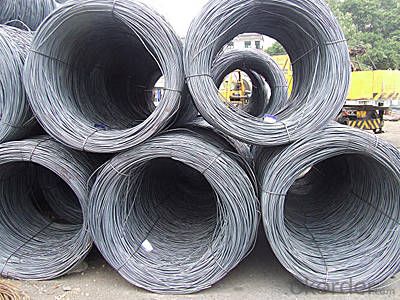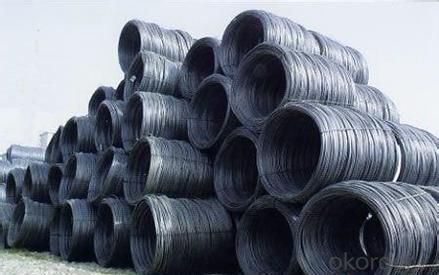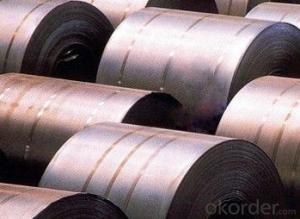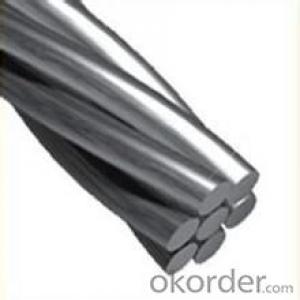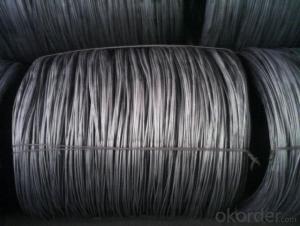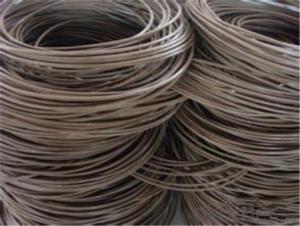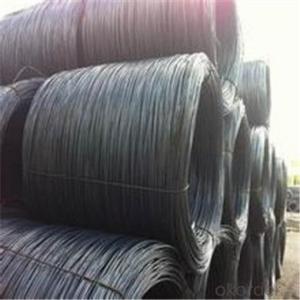Hot Rolled Steel Wire Rod with Good Quality with The Size 6.5mm
- Loading Port:
- Tianjin
- Payment Terms:
- TT OR LC
- Min Order Qty:
- 50 m.t.
- Supply Capability:
- 20000 m.t./month
OKorder Service Pledge
OKorder Financial Service
You Might Also Like
Hot Rolled Steel Wire Rod with Good Quality with The Size 6.5mm
Application: Carbon steel wire rod is widely used in construction and manufacturing. Carbon steel wire rod is mainly used for reinforcement of reinforced concrete and welded structure or reprocessed (roberts , nail, etc.) materials, especially used to produce wire drawing, welding electrode, nails, spring, electronic, precise machinery parts and so on.
Features:
Different Sizes: 5.5mm---16mm
Different Material Grade:SAE1006 SAE1008 SAE1010 SAE1012 etc
Packaging & Delivery of Wire Rod SAE1008B:
Packaging Detail: products are packed in coil and then shipped by container or bulk vessel
Each coil weight: 2-3MT
Delivery Detail: within 45 days after received deposit or LC.
Label: to be specified by customer, generally, each bundle has 1-2 labels
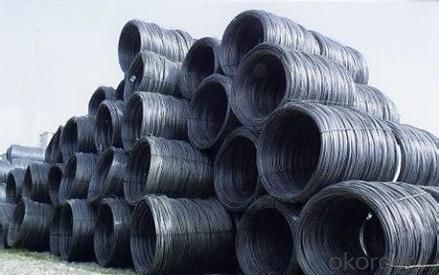
- Q: How are steel wire rods used in the production of wire springs for various mechanical applications?
- The production of wire springs for mechanical applications requires the use of steel wire rods, which are indispensable components. These wire rods are made from top-quality steel and are designed to possess exceptional strength and durability. To ensure compliance with the necessary specifications, the steel wire rods are initially cleaned and inspected in the production process. Subsequently, they undergo a series of procedures involving heating and shaping the rods to achieve the desired wire diameter. This is typically accomplished through a technique known as hot rolling, which involves heating the steel rods to a malleable temperature and then passing them through a set of rollers to reduce their diameter. Once the wire rods have been reduced to the desired diameter, additional treatments are performed to enhance their mechanical properties. This can include heat treatment, which serves to improve the wire's strength and elasticity. This step is crucial in order to ensure that the wire springs can withstand the mechanical stresses they will encounter during use. Following this, the wire rods are coiled onto large spools, ready to be utilized in the manufacturing of wire springs. These spools are typically placed on specialized machinery that automatically feeds the wire into a coiling machine. The coiling machine shapes the wire into the desired spring form, whether it be a compression spring, tension spring, torsion spring, or others. Wire springs produced from steel wire rods offer numerous advantages in mechanical applications. They possess high tensile strength, enabling them to resist deformation and maintain their shape even under heavy loads. Additionally, they exhibit excellent elasticity, allowing them to stretch and return to their original shape without permanent deformation. Wire springs find widespread use in various mechanical applications, including automotive suspension systems, industrial machinery, furniture manufacturing, and numerous other industries. They play a vital role in providing support, absorbing shocks, and storing and releasing mechanical energy. By utilizing steel wire rods, these wire springs can endure the demanding conditions they encounter, ensuring the reliable and efficient operation of diverse mechanical systems.
- Q: How is steel wire rod used in the manufacturing of wire for automotive exhaust systems?
- Steel wire rod is a crucial component in the manufacturing process of wire for automotive exhaust systems. It serves as the raw material for the production of high-quality wire used in these systems. To begin with, steel wire rod undergoes a series of processes to transform it into wire suitable for automotive exhaust systems. The rod is first heated and then passed through a series of rolling mills to reduce its diameter and increase its length. This process, known as hot rolling, ensures that the wire rod achieves the desired dimensions and mechanical properties. Once the wire rod has been rolled to the desired size, it is then subjected to further processing. This may include surface treatment, such as pickling or coating, to enhance its corrosion resistance and durability. Additionally, the wire may undergo specialized heat treatments, such as annealing or quenching, to improve its strength and flexibility. After these treatments, the wire is ready to be used in the manufacturing of automotive exhaust systems. It is typically formed into intricate shapes and configurations to fit specific exhaust components, such as catalytic converters, mufflers, or exhaust pipes. The wire is carefully bent, coiled, or woven to achieve the desired shape and ensure a secure fit within the exhaust system. The wire plays a critical role in the overall performance of automotive exhaust systems. It is used for various purposes, including providing structural support, reducing vibration and noise, and facilitating the flow of exhaust gases. The durability and strength provided by steel wire rod ensure that the wire can withstand the harsh conditions of the exhaust system, including high temperatures, corrosive gases, and mechanical stresses. In summary, steel wire rod is an essential material used in the manufacturing of wire for automotive exhaust systems. Through a series of processing steps, the wire rod is transformed into high-quality wire that is used to create intricate shapes and configurations for exhaust components. The strength, durability, and corrosion resistance of the wire ensure optimal performance of the exhaust system, contributing to the overall efficiency and longevity of the vehicle.
- Q: What are the different types of steel wire rod coatings used for anti-corrosion properties?
- There are several types of steel wire rod coatings used for anti-corrosion properties, including zinc coatings, galvanized coatings, and epoxy coatings. Zinc coatings, such as hot-dip galvanizing or electroplating, provide a sacrificial layer of zinc that corrodes before the steel, protecting it from rust. Galvanized coatings involve a coating of zinc applied to the steel surface through a process of hot-dip galvanization. Epoxy coatings, on the other hand, provide a protective barrier against corrosion by creating a durable and chemically resistant layer on the steel wire rod's surface. These coatings play a crucial role in preventing the steel wire rod from rusting and prolonging its lifespan.
- Q: How does the elongation of steel wire rod vary with different heat treatment processes?
- The elongation of steel wire rod is influenced by different heat treatment processes. Heat treatment involves subjecting the steel wire rod to specific temperatures and cooling rates to alter its structure and properties. One common heat treatment process for steel wire rod is annealing. During annealing, the wire rod is heated to a high temperature and then slowly cooled. This process relieves internal stresses and allows for the formation of a more uniform and ductile microstructure. As a result, the elongation of the steel wire rod typically increases after annealing. The increased elongation is due to the reduction in brittleness and the improved ability of the material to deform without fracturing. On the other hand, another heat treatment process called quenching and tempering involves rapid cooling followed by reheating and slow cooling again. Quenching hardens the steel wire rod, making it stronger and more resistant to deformation. However, this process can also make the material more brittle, reducing its elongation. The subsequent tempering process relieves some of the brittleness while maintaining the strength, resulting in a moderate elongation. In summary, the elongation of steel wire rod varies with different heat treatment processes. Annealing increases elongation by improving ductility and reducing brittleness, while quenching and tempering can result in a moderate elongation by balancing strength and brittleness. The specific heat treatment process chosen for steel wire rod depends on the desired mechanical properties and performance requirements for its intended application.
- Q: What are the different types of steel wire rod surface treatment chemicals?
- There are several different types of steel wire rod surface treatment chemicals that are commonly used in various industries. These chemicals are designed to enhance the properties of the steel wire rod and provide protection against corrosion. Some of the most common types of surface treatment chemicals include: 1. Phosphating chemicals: Phosphating is a common surface treatment process that involves the application of a phosphate coating to the steel wire rod. This coating helps improve the adhesion of paints and other coatings, provides corrosion resistance, and enhances the overall appearance of the wire rod. 2. Pickling chemicals: Pickling is a process that involves the removal of scale and oxides from the surface of the steel wire rod. Pickling chemicals, such as hydrochloric acid or sulfuric acid, are used to dissolve these impurities and leave a clean and smooth surface. 3. Passivation chemicals: Passivation is a chemical process used to remove free iron or iron oxide from the surface of the steel wire rod. This helps to enhance the corrosion resistance of the wire rod by creating a protective oxide layer. 4. Chromate conversion coatings: Chromate conversion coatings are often used as a post-treatment for phosphating or pickling processes. These coatings provide additional corrosion resistance and improve the adhesion of paints or other coatings. 5. Anti-corrosion oils: Anti-corrosion oils are applied to the surface of the steel wire rod to provide temporary protection against corrosion during storage or transportation. These oils form a thin film that helps to prevent moisture and other corrosive substances from reaching the surface of the wire rod. It is important to note that the choice of surface treatment chemical depends on the specific requirements of the steel wire rod and the intended application. Different industries may have their own unique set of requirements and may use different types of surface treatment chemicals accordingly.
- Q: What are the different mechanical testing methods used for steel wire rod?
- There are several mechanical testing methods that are commonly used for steel wire rod in order to assess its quality and performance. These methods include: 1. Tensile testing: This is the most common and fundamental mechanical test for steel wire rod. It involves applying a pulling force to the wire rod until it breaks, in order to measure its ultimate tensile strength, yield strength, and elongation. Tensile testing helps determine the wire rod's ability to withstand stretching or pulling forces without breaking. 2. Hardness testing: Steel wire rod's hardness is an important factor in determining its suitability for specific applications. Various hardness testing methods, such as Brinell, Rockwell, and Vickers, can be employed to measure the wire rod's resistance to indentation or penetration by a hard object. This helps evaluate its strength and durability. 3. Bend testing: This method involves bending the steel wire rod to a specified angle and examining it for cracks or fractures. Bend testing assesses the wire rod's ability to withstand bending forces without failure, which is crucial for applications requiring flexibility or resistance to deformation. 4. Fatigue testing: Steel wire rod often experiences cyclic loading and unloading during its service life. Fatigue testing is conducted to evaluate the wire rod's resistance to repeated loading and unloading cycles. This test helps determine its endurance limit, fatigue strength, and fatigue life, ensuring the wire rod's reliability in applications with dynamic or cyclic loads. 5. Impact testing: Steel wire rod may encounter sudden impact or shock loads, especially in applications involving machinery or structural components. Impact testing measures the wire rod's ability to absorb energy and resist fracture under high-velocity loading. This test provides insights into its toughness and resistance to sudden loading, helping assess its suitability for impact-prone applications. By employing these various mechanical testing methods, manufacturers and users of steel wire rod can ensure its quality, performance, and suitability for specific applications.
- Q: What are the main factors influencing the choice of steel wire rod warranty?
- The choice of steel wire rod warranty is influenced by several key factors. Firstly, the quality of the steel wire rod is crucial. Buyers prefer a high-quality product that is unlikely to have defects or issues, reducing the need for warranty claims. Factors such as strength, durability, and overall performance play a significant role in determining confidence in the product and, consequently, the warranty. Secondly, the reputation of the manufacturer is another important consideration. Buyers are more likely to trust a manufacturer with a proven track record of producing high-quality steel wire rods and providing reliable warranties. Positive reviews, testimonials, and references from other customers can provide valuable insights into the manufacturer's commitment to customer satisfaction and after-sales service. Lastly, the terms and conditions of the warranty itself are essential. Buyers carefully consider factors such as the duration of the warranty, the extent of coverage it offers, and any limitations or exclusions stated in the warranty documentation. A longer warranty period and comprehensive coverage, including protection against manufacturing defects or premature failure, are often preferred. Additionally, factors such as the process for filing warranty claims, the responsiveness of the manufacturer's customer service, and the ease of warranty fulfillment are also taken into account. To summarize, the main factors influencing the choice of steel wire rod warranty are the quality of the product, the reputation of the manufacturer, and the terms and conditions of the warranty. Buyers prioritize a high-quality product, a reputable manufacturer, and a warranty with favorable terms and comprehensive coverage.
- Q: How is the steel wire rod market segmented by application?
- Steel wire rods are utilized in a wide range of industries, with each sector having specific applications for these rods. The construction industry, for example, commonly incorporates steel wire rods into concrete structures such as buildings, bridges, and highways to enhance their strength and durability. By reinforcing these structures, the rods ensure that they can withstand various forces and maintain stability. Similarly, the automotive industry relies heavily on steel wire rods for manufacturing different components like springs, suspension systems, and wire harnesses. The high tensile strength of these rods makes them suitable for use in automotive systems that face demanding conditions. In the energy sector, steel wire rods play a significant role in the production of power transmission cables and electrical wiring. The conductors manufactured from these rods efficiently transport electricity over long distances while minimizing energy loss. The industrial sector also benefits from the use of steel wire rods, which find applications in machinery, appliances, and manufacturing. These rods are utilized for producing mechanical components like fasteners, bolts, and nuts that require strength and reliability. In addition to these major segments, steel wire rods have diverse applications in sectors such as agriculture, aerospace, and consumer goods. For instance, in agriculture, these rods are used for fencing, trellising, and supporting structures. In aerospace, they contribute to the manufacturing of aircraft cables, suspension systems, and other critical components. Overall, the varied applications of steel wire rods in different industries have led to the segmentation of the steel wire rod market by application. The versatility and strength of these rods make them indispensable in various sectors, enabling the production of robust and reliable products.
- Q: How are steel wire rods used in the automotive industry?
- The automotive industry widely employs steel wire rods for various purposes. One of their main uses is in the production of suspension systems, where they are utilized to create crucial components like coil springs, torsion bars, and stabilizer bars. These components play a vital role in ensuring the vehicle's stability and providing a smooth ride. Steel wire rods are also extensively used in the manufacturing of automotive tires. They serve as reinforcement materials for the tire belts, adding strength and durability. These wire rods are typically embedded in the rubber, enhancing the overall structural integrity and resistance to wear and tear. Furthermore, steel wire rods are an essential part of seat frames and seat belts. They form the framework of the seats, offering support and stability to the occupants. In seat belts, the wire rods are utilized as the inner structure, ensuring strength and the ability to withstand impacts during collisions. Moreover, automotive springs, such as those used in the suspension system, clutch, brakes, and seat mechanisms, are made from steel wire rods. These wire rods are coiled to provide the necessary elasticity and resilience required for these components to function effectively. Additionally, steel wire rods are employed in the production of automotive cables. These cables transmit power and signals to various parts of the vehicle, including the accelerator, brakes, and clutch. The wire rods serve as the inner core of these cables, ensuring their strength and durability. In conclusion, steel wire rods have extensive applications in the automotive industry. They are used in suspension systems, tire manufacturing, seat frames, seat belts, springs, and cables. The utilization of steel wire rods in these components greatly enhances the overall performance, safety, and reliability of vehicles.
- Q: How is steel wire rod used in the manufacturing of wire forms for industrial filters?
- Steel wire rod is a crucial component in the manufacturing process of wire forms for industrial filters. The wire rod is first subjected to a series of mechanical and chemical processes to ensure its durability and strength. Once it meets the required specifications, it is then transformed into various wire forms that are used in the construction of industrial filters. One of the primary uses of steel wire rod in manufacturing wire forms for industrial filters is to create the support structure. The wire rod is typically bent, twisted, or welded to form a sturdy framework that holds the filter together. This support structure ensures that the filter is able to withstand the pressure and stress it will encounter during its operation. Additionally, steel wire rod is used to create the filtering elements within the industrial filters. These filtering elements are often made by weaving, knitting, or welding the wire rod into a mesh or screen-like structure. This allows the filter to efficiently trap and remove unwanted particles or contaminants from various fluids or gases. The strength and durability of steel wire rod make it an ideal material for manufacturing wire forms for industrial filters. It can withstand high temperatures, corrosive environments, and heavy loads, ensuring that the filter remains functional and reliable in challenging industrial settings. Furthermore, steel wire rod can be easily manipulated and customized to meet specific requirements. Different diameters, tensile strengths, and surface finishes can be achieved by selecting the appropriate steel grade and applying specific manufacturing techniques. This versatility allows manufacturers to create wire forms that are tailored to the specific needs of different industrial applications. In conclusion, steel wire rod plays a vital role in the manufacturing of wire forms for industrial filters. Its strength, durability, and versatility make it an essential material for creating the support structures and filtering elements that are necessary for the proper functioning of these filters.
Send your message to us
Hot Rolled Steel Wire Rod with Good Quality with The Size 6.5mm
- Loading Port:
- Tianjin
- Payment Terms:
- TT OR LC
- Min Order Qty:
- 50 m.t.
- Supply Capability:
- 20000 m.t./month
OKorder Service Pledge
OKorder Financial Service
Similar products
Hot products
Hot Searches
Related keywords



